Abstract
Epidemiological studies have identified several factors that are likely to have a major effect on reducing rates of cancer: reduction of smoking, increased consumption of fruits and vegetables, and control of infections. Other factors include avoidance of intense sun exposure, increased physical activity, and reduced consumption of alcohol and possibly red meat. Risks of many types of cancer can already be reduced, and the potential for further reductions is great. In the United States, cancer death rates for all cancers combined are decreasing, if lung cancer (90% of which is due to smoking), is excluded from the analysis. We review the research on causes of cancer and show why much cancer is preventable. The idea that traces of synthetic chemicals, such as DDT, are major contributors to human cancer is not supported by the evidence, yet public concern and resource allocation for reduction of chemical pollution are very high, in part because standard risk assessment uses linear extrapolation from limited data in high-dose animal cancer tests. These tests are done at the maximum tolerated dose (MTD) and are typically misinterpreted to mean that low doses of synthetic chemicals and industrial pollutants are relevant to human cancer. About half the chemicals tested, whether synthetic or natural, are carcinogenic to rodents at such high doses. Almost all chemicals in the human diet are natural. For example, 99.99% of the pesticides we eat are naturally present in plants to ward off insects and other predators. Half of the natural pesticides that have been tested at the MTD are rodent carcinogens. Cooking food produces large numbers of natural dietary chemicals. Roasted coffee, for example, contains more than 1000 chemicals: of 27 tested, 19 are rodent carcinogens. Increasing evidence supports the idea that the high frequency of positive results in rodent bioassays is due to testing at the MTD, which frequently can cause chronic cell killing and consequent cell replacement-a risk factor for cancer that can be limited to high doses. Because default risk assessments use linear extrapolation, which ignores effects of the high dose itself, low-dose risks are often exaggerated.
Full text
PDF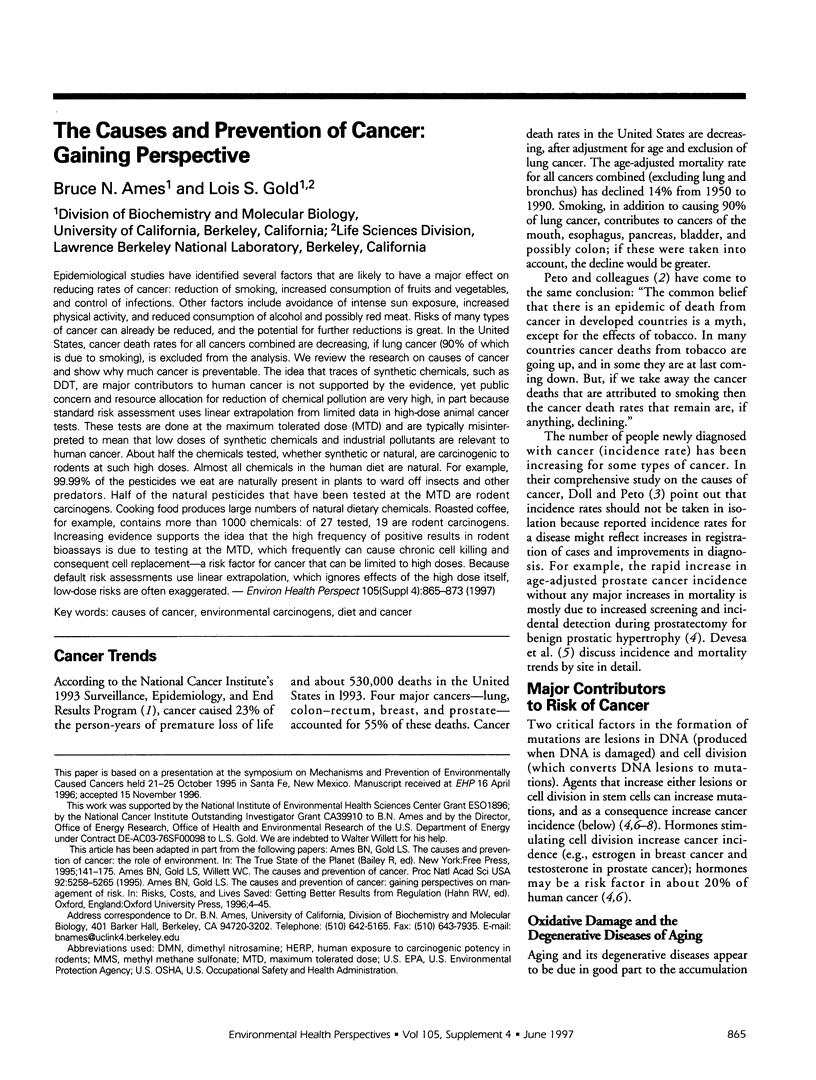
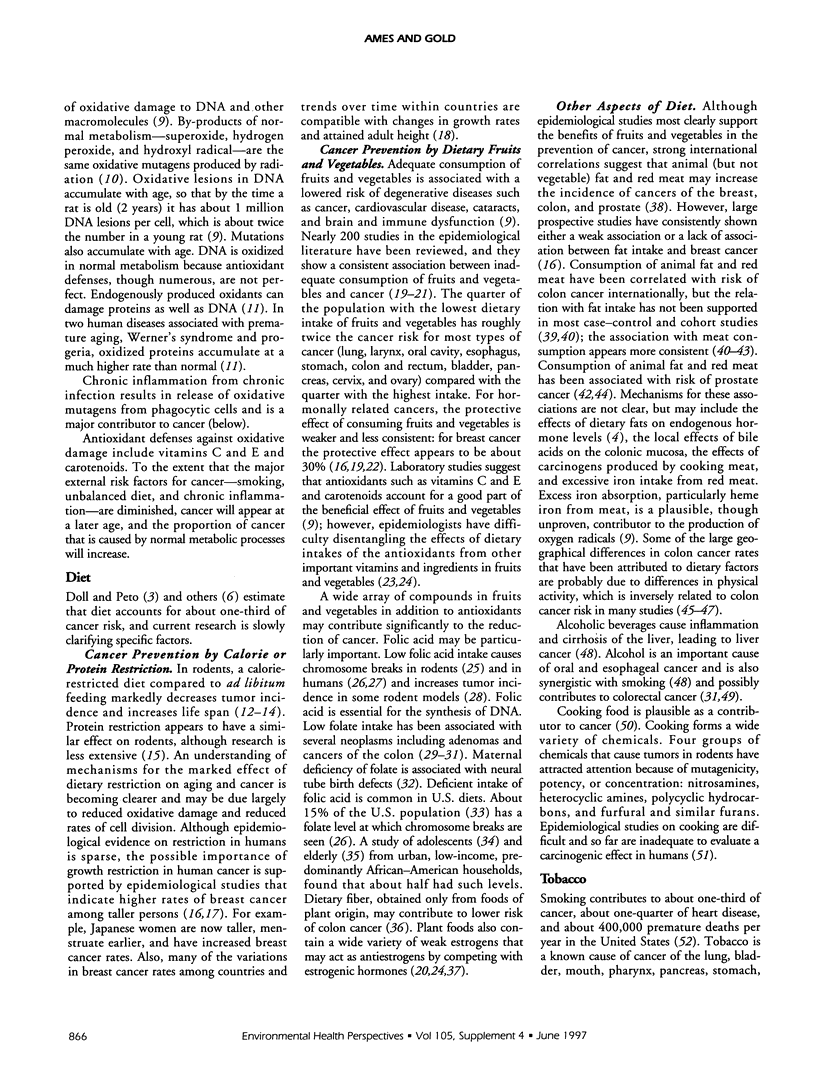
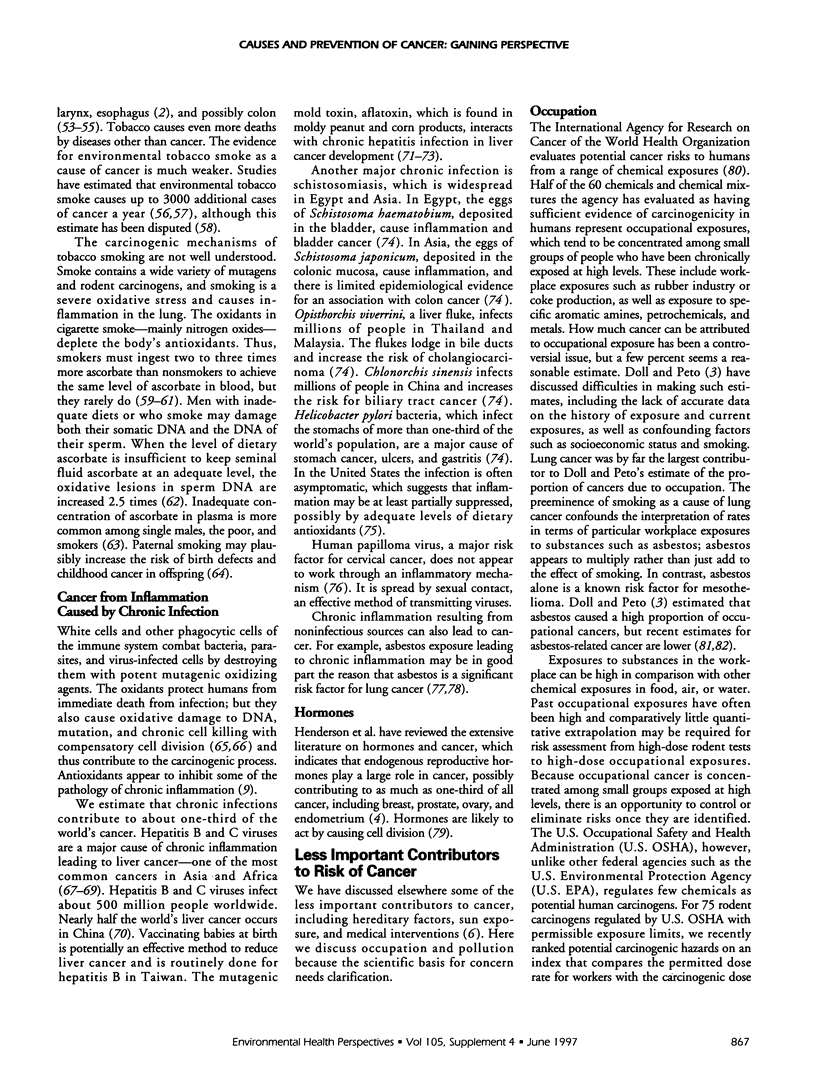
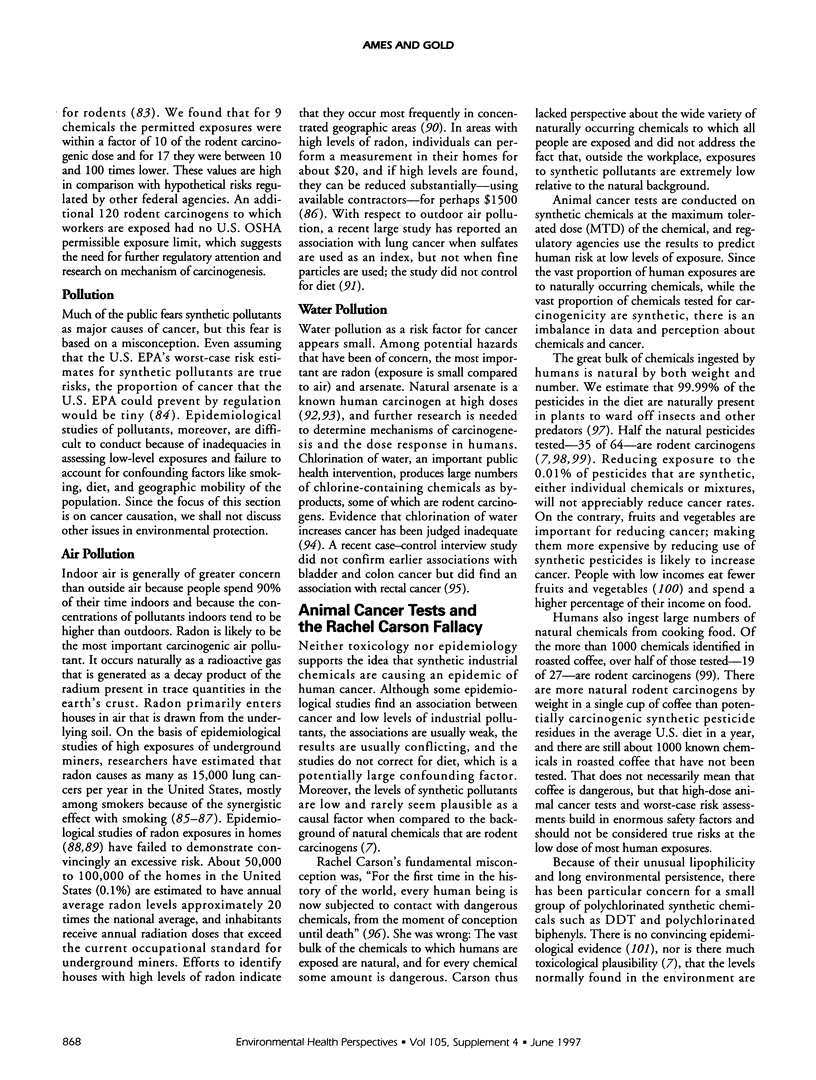
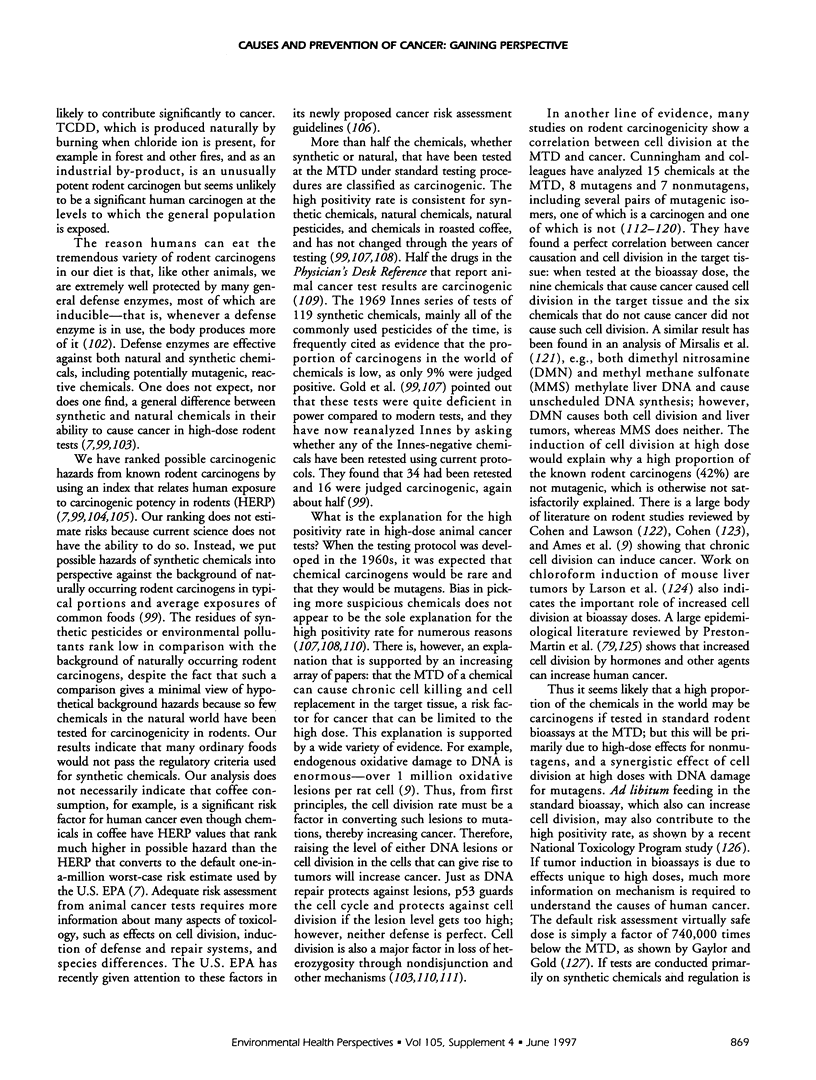
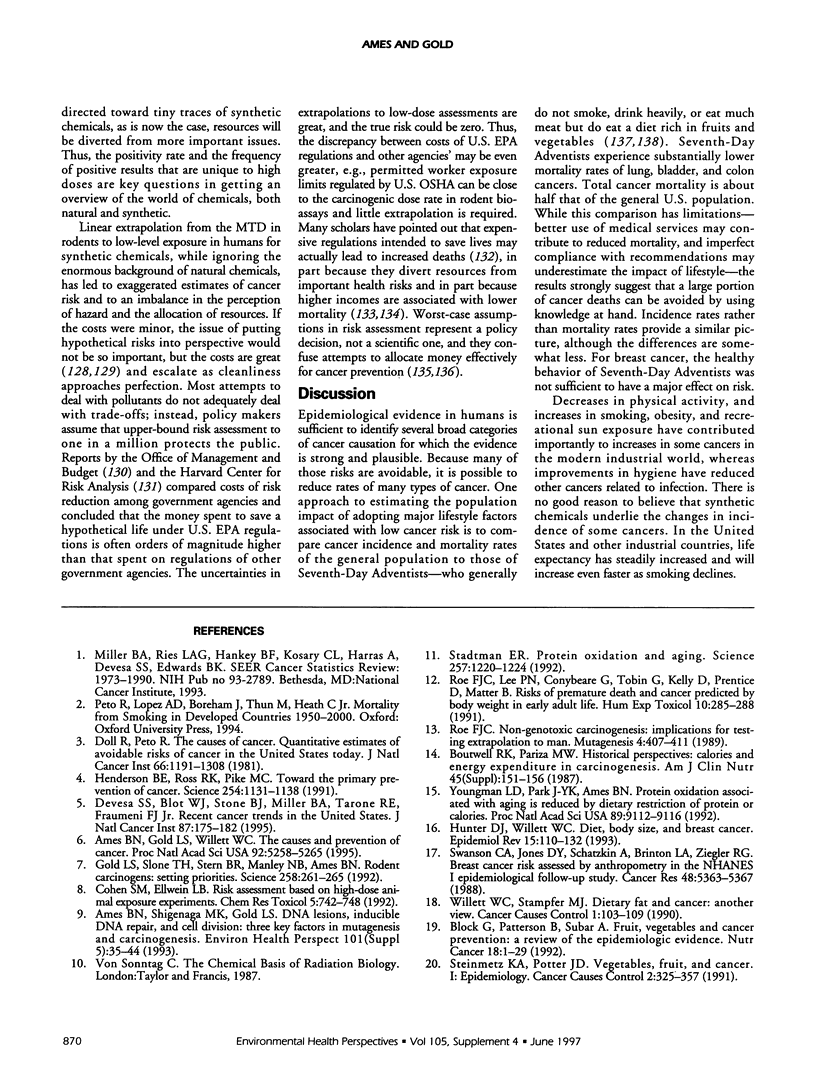
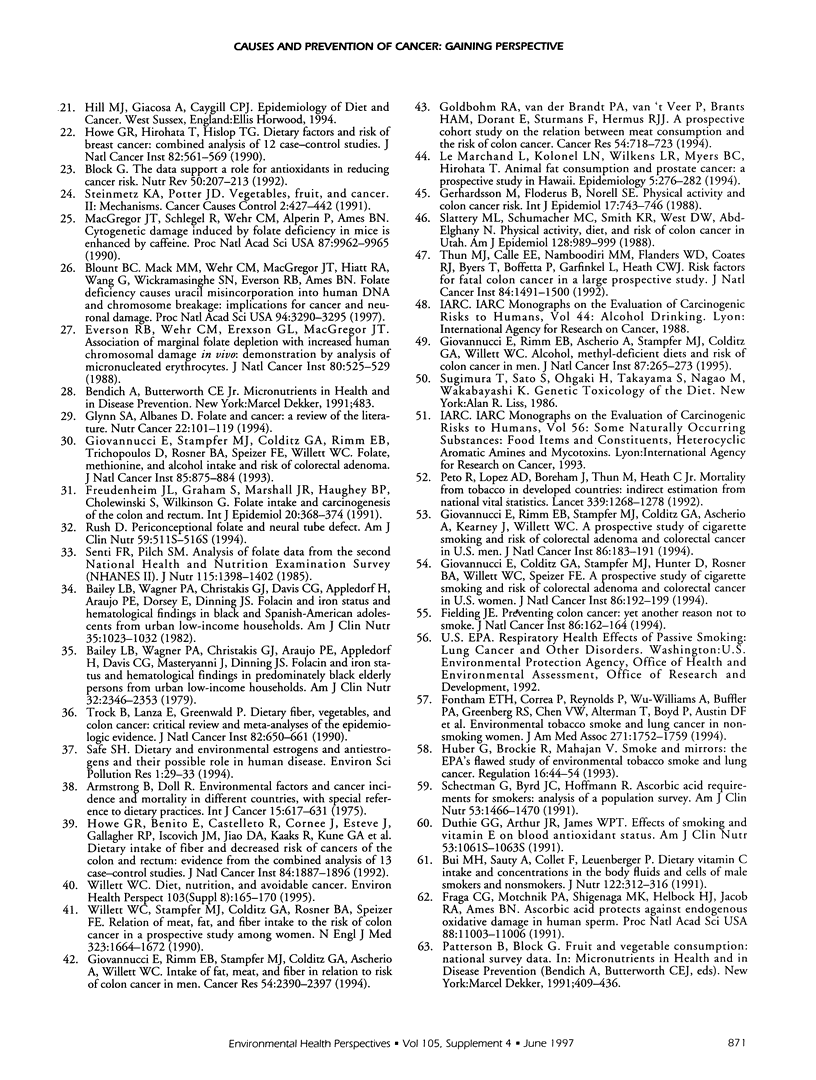
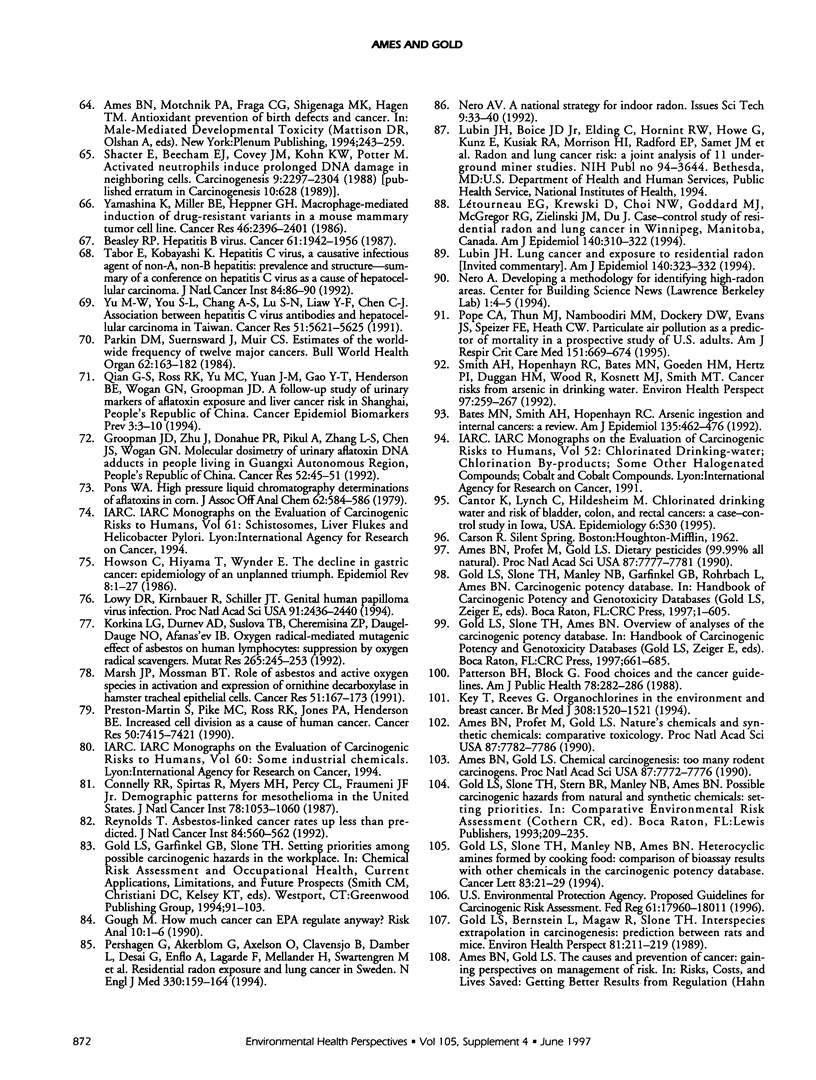
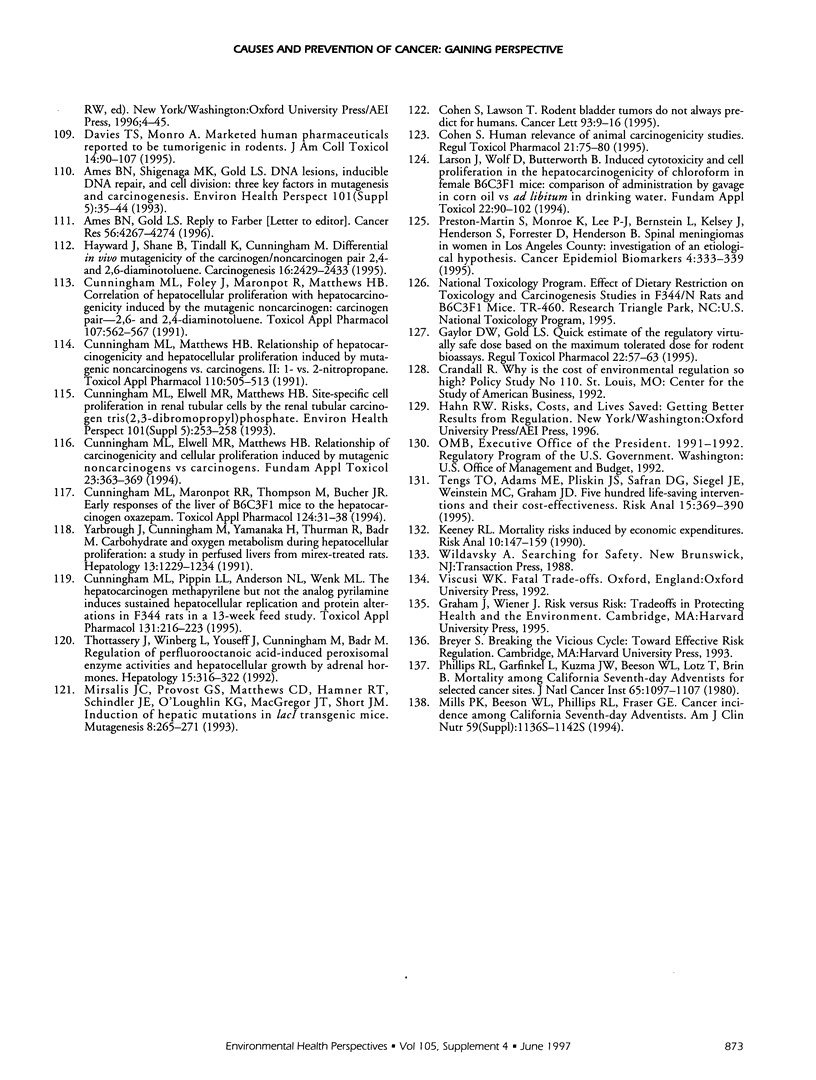
Selected References
These references are in PubMed. This may not be the complete list of references from this article.
- Ames B. N., Gold L. S. Chemical carcinogenesis: too many rodent carcinogens. Proc Natl Acad Sci U S A. 1990 Oct;87(19):7772–7776. doi: 10.1073/pnas.87.19.7772. [DOI] [PMC free article] [PubMed] [Google Scholar]
- Ames B. N., Gold L. S. Re: E. Farber, Cell proliferation as a major risk factor for cancer: a concept of doubtful validity. Cancer Res., 55: 3759-3762, 1995. Cancer Res. 1996 Sep 15;56(18):4267–4274. [PubMed] [Google Scholar]
- Ames B. N., Gold L. S., Willett W. C. The causes and prevention of cancer. Proc Natl Acad Sci U S A. 1995 Jun 6;92(12):5258–5265. doi: 10.1073/pnas.92.12.5258. [DOI] [PMC free article] [PubMed] [Google Scholar]
- Ames B. N., Profet M., Gold L. S. Dietary pesticides (99.99% all natural). Proc Natl Acad Sci U S A. 1990 Oct;87(19):7777–7781. doi: 10.1073/pnas.87.19.7777. [DOI] [PMC free article] [PubMed] [Google Scholar]
- Ames B. N., Profet M., Gold L. S. Nature's chemicals and synthetic chemicals: comparative toxicology. Proc Natl Acad Sci U S A. 1990 Oct;87(19):7782–7786. doi: 10.1073/pnas.87.19.7782. [DOI] [PMC free article] [PubMed] [Google Scholar]
- Ames B. N., Shigenaga M. K., Gold L. S. DNA lesions, inducible DNA repair, and cell division: three key factors in mutagenesis and carcinogenesis. Environ Health Perspect. 1993 Dec;101 (Suppl 5):35–44. doi: 10.1289/ehp.93101s535. [DOI] [PMC free article] [PubMed] [Google Scholar]
- Ames B. N., Shigenaga M. K., Gold L. S. DNA lesions, inducible DNA repair, and cell division: three key factors in mutagenesis and carcinogenesis. Environ Health Perspect. 1993 Dec;101 (Suppl 5):35–44. doi: 10.1289/ehp.93101s535. [DOI] [PMC free article] [PubMed] [Google Scholar]
- Armstrong B., Doll R. Environmental factors and cancer incidence and mortality in different countries, with special reference to dietary practices. Int J Cancer. 1975 Apr 15;15(4):617–631. doi: 10.1002/ijc.2910150411. [DOI] [PubMed] [Google Scholar]
- Bailey L. B., Wagner P. A., Christakis G. J., Araujo P. E., Appledorf H., Davis C. G., Masteryanni J., Dinning J. S. Folacin and iron status and hematological findings in predominately black elderly persons from urban low-income households. Am J Clin Nutr. 1979 Nov;32(11):2346–2353. doi: 10.1093/ajcn/32.11.2346. [DOI] [PubMed] [Google Scholar]
- Bailey L. B., Wagner P. A., Christakis G. J., Davis C. G., Appledorf H., Araujo P. E., Dorsey E., Dinning J. S. Folacin and iron status and hematological findings in black and Spanish-American adolescents from urban low-income households. Am J Clin Nutr. 1982 May;35(5):1023–1032. doi: 10.1093/ajcn/35.5.1023. [DOI] [PubMed] [Google Scholar]
- Bates M. N., Smith A. H., Hopenhayn-Rich C. Arsenic ingestion and internal cancers: a review. Am J Epidemiol. 1992 Mar 1;135(5):462–476. doi: 10.1093/oxfordjournals.aje.a116313. [DOI] [PubMed] [Google Scholar]
- Beasley R. P. Hepatitis B virus. The major etiology of hepatocellular carcinoma. Cancer. 1988 May 15;61(10):1942–1956. doi: 10.1002/1097-0142(19880515)61:10<1942::aid-cncr2820611003>3.0.co;2-j. [DOI] [PubMed] [Google Scholar]
- Block G., Patterson B., Subar A. Fruit, vegetables, and cancer prevention: a review of the epidemiological evidence. Nutr Cancer. 1992;18(1):1–29. doi: 10.1080/01635589209514201. [DOI] [PubMed] [Google Scholar]
- Block G. The data support a role for antioxidants in reducing cancer risk. Nutr Rev. 1992 Jul;50(7):207–213. doi: 10.1111/j.1753-4887.1992.tb01329.x. [DOI] [PubMed] [Google Scholar]
- Blount B. C., Mack M. M., Wehr C. M., MacGregor J. T., Hiatt R. A., Wang G., Wickramasinghe S. N., Everson R. B., Ames B. N. Folate deficiency causes uracil misincorporation into human DNA and chromosome breakage: implications for cancer and neuronal damage. Proc Natl Acad Sci U S A. 1997 Apr 1;94(7):3290–3295. doi: 10.1073/pnas.94.7.3290. [DOI] [PMC free article] [PubMed] [Google Scholar]
- Bui M. H., Sauty A., Collet F., Leuenberger P. Dietary vitamin C intake and concentrations in the body fluids and cells of male smokers and nonsmokers. J Nutr. 1992 Feb;122(2):312–316. doi: 10.1093/jn/122.2.312. [DOI] [PubMed] [Google Scholar]
- Cohen S. M., Ellwein L. B. Risk assessment based on high-dose animal exposure experiments. Chem Res Toxicol. 1992 Nov-Dec;5(6):742–748. doi: 10.1021/tx00030a002. [DOI] [PubMed] [Google Scholar]
- Cohen S. M. Human relevance of animal carcinogenicity studies. Regul Toxicol Pharmacol. 1995 Feb;21(1):75–86. doi: 10.1006/rtph.1995.1012. [DOI] [PubMed] [Google Scholar]
- Cohen S. M., Lawson T. A. Rodent bladder tumors do not always predict for humans. Cancer Lett. 1995 Jun 29;93(1):9–16. doi: 10.1016/0304-3835(95)03785-U. [DOI] [PubMed] [Google Scholar]
- Connelly R. R., Spirtas R., Myers M. H., Percy C. L., Fraumeni J. F., Jr Demographic patterns for mesothelioma in the United States. J Natl Cancer Inst. 1987 Jun;78(6):1053–1060. [PubMed] [Google Scholar]
- Cunningham M. L., Elwell M. R., Matthews H. B. Relationship of carcinogenicity and cellular proliferation induced by mutagenic noncarcinogens vs carcinogens. III. Organophosphate pesticides vs tris(2,3-dibromopropyl)phosphate. Fundam Appl Toxicol. 1994 Oct;23(3):363–369. doi: 10.1006/faat.1994.1116. [DOI] [PubMed] [Google Scholar]
- Cunningham M. L., Elwell M. R., Matthews H. B. Site-specific cell proliferation in renal tubular cells by the renal tubular carcinogen tris(2,3-dibromopropyl)phosphate. Environ Health Perspect. 1993 Dec;101 (Suppl 5):253–257. doi: 10.1289/ehp.93101s5253. [DOI] [PMC free article] [PubMed] [Google Scholar]
- Cunningham M. L., Foley J., Maronpot R. R., Matthews H. B. Correlation of hepatocellular proliferation with hepatocarcinogenicity induced by the mutagenic noncarcinogen:carcinogen pair--2,6- and 2,4-diaminotoluene. Toxicol Appl Pharmacol. 1991 Mar 1;107(3):562–567. doi: 10.1016/0041-008x(91)90319-a. [DOI] [PubMed] [Google Scholar]
- Cunningham M. L., Maronpot R. R., Thompson M., Bucher J. R. Early responses of the liver of B6C3F1 mice to the hepatocarcinogen oxazepam. Toxicol Appl Pharmacol. 1994 Jan;124(1):31–38. doi: 10.1006/taap.1994.1005. [DOI] [PubMed] [Google Scholar]
- Cunningham M. L., Matthews H. B. Relationship of hepatocarcinogenicity and hepatocellular proliferation induced by mutagenic noncarcinogens vs carcinogens. II. 1- vs 2-nitropropane. Toxicol Appl Pharmacol. 1991 Sep 15;110(3):505–513. doi: 10.1016/0041-008x(91)90050-o. [DOI] [PubMed] [Google Scholar]
- Cunningham M. L., Pippin L. L., Anderson N. L., Wenk M. L. The hepatocarcinogen methapyrilene but not the analog pyrilamine induces sustained hepatocellular replication and protein alterations in F344 rats in a 13-week feed study. Toxicol Appl Pharmacol. 1995 Apr;131(2):216–223. doi: 10.1006/taap.1995.1064. [DOI] [PubMed] [Google Scholar]
- Devesa S. S., Blot W. J., Stone B. J., Miller B. A., Tarone R. E., Fraumeni J. F., Jr Recent cancer trends in the United States. J Natl Cancer Inst. 1995 Feb 1;87(3):175–182. doi: 10.1093/jnci/87.3.175. [DOI] [PubMed] [Google Scholar]
- Doll R., Peto R. The causes of cancer: quantitative estimates of avoidable risks of cancer in the United States today. J Natl Cancer Inst. 1981 Jun;66(6):1191–1308. [PubMed] [Google Scholar]
- Duthie G. G., Arthur J. R., James W. P. Effects of smoking and vitamin E on blood antioxidant status. Am J Clin Nutr. 1991 Apr;53(4 Suppl):1061S–1063S. doi: 10.1093/ajcn/53.4.1061S. [DOI] [PubMed] [Google Scholar]
- Everson R. B., Wehr C. M., Erexson G. L., MacGregor J. T. Association of marginal folate depletion with increased human chromosomal damage in vivo: demonstration by analysis of micronucleated erythrocytes. J Natl Cancer Inst. 1988 Jun 1;80(7):525–529. doi: 10.1093/jnci/80.7.525. [DOI] [PubMed] [Google Scholar]
- Fielding J. E. Preventing colon cancer: yet another reason not to smoke. J Natl Cancer Inst. 1994 Feb 2;86(3):162–164. doi: 10.1093/jnci/86.3.162. [DOI] [PubMed] [Google Scholar]
- Fontham E. T., Correa P., Reynolds P., Wu-Williams A., Buffler P. A., Greenberg R. S., Chen V. W., Alterman T., Boyd P., Austin D. F. Environmental tobacco smoke and lung cancer in nonsmoking women. A multicenter study. JAMA. 1994 Jun 8;271(22):1752–1759. [PubMed] [Google Scholar]
- Fraga C. G., Motchnik P. A., Shigenaga M. K., Helbock H. J., Jacob R. A., Ames B. N. Ascorbic acid protects against endogenous oxidative DNA damage in human sperm. Proc Natl Acad Sci U S A. 1991 Dec 15;88(24):11003–11006. doi: 10.1073/pnas.88.24.11003. [DOI] [PMC free article] [PubMed] [Google Scholar]
- Freudenheim J. L., Graham S., Marshall J. R., Haughey B. P., Cholewinski S., Wilkinson G. Folate intake and carcinogenesis of the colon and rectum. Int J Epidemiol. 1991 Jun;20(2):368–374. doi: 10.1093/ije/20.2.368. [DOI] [PubMed] [Google Scholar]
- Gaylor D. W., Gold L. S. Quick estimate of the regulatory virtually safe dose based on the maximum tolerated dose for rodent bioassays. Regul Toxicol Pharmacol. 1995 Aug;22(1):57–63. doi: 10.1006/rtph.1995.1069. [DOI] [PubMed] [Google Scholar]
- Gerhardsson M., Floderus B., Norell S. E. Physical activity and colon cancer risk. Int J Epidemiol. 1988 Dec;17(4):743–746. doi: 10.1093/ije/17.4.743. [DOI] [PubMed] [Google Scholar]
- Giovannucci E., Colditz G. A., Stampfer M. J., Hunter D., Rosner B. A., Willett W. C., Speizer F. E. A prospective study of cigarette smoking and risk of colorectal adenoma and colorectal cancer in U.S. women. J Natl Cancer Inst. 1994 Feb 2;86(3):192–199. doi: 10.1093/jnci/86.3.192. [DOI] [PubMed] [Google Scholar]
- Giovannucci E., Rimm E. B., Ascherio A., Stampfer M. J., Colditz G. A., Willett W. C. Alcohol, low-methionine--low-folate diets, and risk of colon cancer in men. J Natl Cancer Inst. 1995 Feb 15;87(4):265–273. doi: 10.1093/jnci/87.4.265. [DOI] [PubMed] [Google Scholar]
- Giovannucci E., Rimm E. B., Stampfer M. J., Colditz G. A., Ascherio A., Kearney J., Willett W. C. A prospective study of cigarette smoking and risk of colorectal adenoma and colorectal cancer in U.S. men. J Natl Cancer Inst. 1994 Feb 2;86(3):183–191. doi: 10.1093/jnci/86.3.183. [DOI] [PubMed] [Google Scholar]
- Giovannucci E., Rimm E. B., Stampfer M. J., Colditz G. A., Ascherio A., Willett W. C. Intake of fat, meat, and fiber in relation to risk of colon cancer in men. Cancer Res. 1994 May 1;54(9):2390–2397. [PubMed] [Google Scholar]
- Giovannucci E., Stampfer M. J., Colditz G. A., Rimm E. B., Trichopoulos D., Rosner B. A., Speizer F. E., Willett W. C. Folate, methionine, and alcohol intake and risk of colorectal adenoma. J Natl Cancer Inst. 1993 Jun 2;85(11):875–884. doi: 10.1093/jnci/85.11.875. [DOI] [PubMed] [Google Scholar]
- Glynn S. A., Albanes D. Folate and cancer: a review of the literature. Nutr Cancer. 1994;22(2):101–119. doi: 10.1080/01635589409514336. [DOI] [PubMed] [Google Scholar]
- Gold L. S., Bernstein L., Magaw R., Slone T. H. Interspecies extrapolation in carcinogenesis: prediction between rats and mice. Environ Health Perspect. 1989 May;81:211–219. doi: 10.1289/ehp.8981211. [DOI] [PMC free article] [PubMed] [Google Scholar]
- Gold L. S., Slone T. H., Manley N. B., Ames B. N. Heterocyclic amines formed by cooking food: comparison of bioassay results with other chemicals in the Carcinogenic Potency Database. Cancer Lett. 1994 Aug 15;83(1-2):21–29. doi: 10.1016/0304-3835(94)90294-1. [DOI] [PubMed] [Google Scholar]
- Gold L. S., Slone T. H., Stern B. R., Manley N. B., Ames B. N. Rodent carcinogens: setting priorities. Science. 1992 Oct 9;258(5080):261–265. doi: 10.1126/science.1411524. [DOI] [PubMed] [Google Scholar]
- Goldbohm R. A., van den Brandt P. A., van 't Veer P., Brants H. A., Dorant E., Sturmans F., Hermus R. J. A prospective cohort study on the relation between meat consumption and the risk of colon cancer. Cancer Res. 1994 Feb 1;54(3):718–723. [PubMed] [Google Scholar]
- Gough M. How much cancer can EPA regulate away? Risk Anal. 1990 Mar;10(1):1–6. doi: 10.1111/j.1539-6924.1990.tb01011.x. [DOI] [PubMed] [Google Scholar]
- Groopman J. D., Zhu J. Q., Donahue P. R., Pikul A., Zhang L. S., Chen J. S., Wogan G. N. Molecular dosimetry of urinary aflatoxin-DNA adducts in people living in Guangxi Autonomous Region, People's Republic of China. Cancer Res. 1992 Jan 1;52(1):45–52. [PubMed] [Google Scholar]
- Hayward J. J., Shane B. S., Tindall K. R., Cunningham M. L. Differential in vivo mutagenicity of the carcinogen/non-carcinogen pair 2,4- and 2,6-diaminotoluene. Carcinogenesis. 1995 Oct;16(10):2429–2433. doi: 10.1093/carcin/16.10.2429. [DOI] [PubMed] [Google Scholar]
- Henderson B. E., Ross R. K., Pike M. C. Toward the primary prevention of cancer. Science. 1991 Nov 22;254(5035):1131–1138. doi: 10.1126/science.1957166. [DOI] [PubMed] [Google Scholar]
- Howe G. R., Benito E., Castelleto R., Cornée J., Estève J., Gallagher R. P., Iscovich J. M., Deng-ao J., Kaaks R., Kune G. A. Dietary intake of fiber and decreased risk of cancers of the colon and rectum: evidence from the combined analysis of 13 case-control studies. J Natl Cancer Inst. 1992 Dec 16;84(24):1887–1896. doi: 10.1093/jnci/84.24.1887. [DOI] [PubMed] [Google Scholar]
- Howe G. R., Hirohata T., Hislop T. G., Iscovich J. M., Yuan J. M., Katsouyanni K., Lubin F., Marubini E., Modan B., Rohan T. Dietary factors and risk of breast cancer: combined analysis of 12 case-control studies. J Natl Cancer Inst. 1990 Apr 4;82(7):561–569. doi: 10.1093/jnci/82.7.561. [DOI] [PubMed] [Google Scholar]
- Howson C. P., Hiyama T., Wynder E. L. The decline in gastric cancer: epidemiology of an unplanned triumph. Epidemiol Rev. 1986;8:1–27. doi: 10.1093/oxfordjournals.epirev.a036288. [DOI] [PubMed] [Google Scholar]
- Hunter D. J., Willett W. C. Diet, body size, and breast cancer. Epidemiol Rev. 1993;15(1):110–132. doi: 10.1093/oxfordjournals.epirev.a036096. [DOI] [PubMed] [Google Scholar]
- Keeney R. L. Mortality risks induced by economic expenditures. Risk Anal. 1990 Mar;10(1):147–159. doi: 10.1111/j.1539-6924.1990.tb01029.x. [DOI] [PubMed] [Google Scholar]
- Key T., Reeves G. Organochlorines in the environment and breast cancer. BMJ. 1994 Jun 11;308(6943):1520–1521. doi: 10.1136/bmj.308.6943.1520. [DOI] [PMC free article] [PubMed] [Google Scholar]
- Korkina L. G., Durnev A. D., Suslova T. B., Cheremisina Z. P., Daugel-Dauge N. O., Afanas'ev I. B. Oxygen radical-mediated mutagenic effect of asbestos on human lymphocytes: suppression by oxygen radical scavengers. Mutat Res. 1992 Feb;265(2):245–253. doi: 10.1016/0027-5107(92)90053-5. [DOI] [PubMed] [Google Scholar]
- Larson J. L., Wolf D. C., Butterworth B. E. Induced cytotoxicity and cell proliferation in the hepatocarcinogenicity of chloroform in female B6C3F1 mice: comparison of administration by gavage in corn oil vs ad libitum in drinking water. Fundam Appl Toxicol. 1994 Jan;22(1):90–102. doi: 10.1006/faat.1994.1012. [DOI] [PubMed] [Google Scholar]
- Le Marchand L., Kolonel L. N., Wilkens L. R., Myers B. C., Hirohata T. Animal fat consumption and prostate cancer: a prospective study in Hawaii. Epidemiology. 1994 May;5(3):276–282. doi: 10.1097/00001648-199405000-00004. [DOI] [PubMed] [Google Scholar]
- Lowy D. R., Kirnbauer R., Schiller J. T. Genital human papillomavirus infection. Proc Natl Acad Sci U S A. 1994 Mar 29;91(7):2436–2440. doi: 10.1073/pnas.91.7.2436. [DOI] [PMC free article] [PubMed] [Google Scholar]
- Lubin J. H. Invited commentary: lung cancer and exposure to residential radon. Am J Epidemiol. 1994 Aug 15;140(4):323–332. doi: 10.1093/oxfordjournals.aje.a117254. [DOI] [PubMed] [Google Scholar]
- Létourneau E. G., Krewski D., Choi N. W., Goddard M. J., McGregor R. G., Zielinski J. M., Du J. Case-control study of residential radon and lung cancer in Winnipeg, Manitoba, Canada. Am J Epidemiol. 1994 Aug 15;140(4):310–322. doi: 10.1093/oxfordjournals.aje.a117253. [DOI] [PubMed] [Google Scholar]
- MacGregor J. T., Schlegel R., Wehr C. M., Alperin P., Ames B. N. Cytogenetic damage induced by folate deficiency in mice is enhanced by caffeine. Proc Natl Acad Sci U S A. 1990 Dec;87(24):9962–9965. doi: 10.1073/pnas.87.24.9962. [DOI] [PMC free article] [PubMed] [Google Scholar]
- Marsh J. P., Mossman B. T. Role of asbestos and active oxygen species in activation and expression of ornithine decarboxylase in hamster tracheal epithelial cells. Cancer Res. 1991 Jan 1;51(1):167–173. [PubMed] [Google Scholar]
- Mills P. K., Beeson W. L., Phillips R. L., Fraser G. E. Cancer incidence among California Seventh-Day Adventists, 1976-1982. Am J Clin Nutr. 1994 May;59(5 Suppl):1136S–1142S. doi: 10.1093/ajcn/59.5.1136S. [DOI] [PubMed] [Google Scholar]
- Mirsalis J. C., Provost G. S., Matthews C. D., Hamner R. T., Schindler J. E., O'Loughlin K. G., MacGregor J. T., Short J. M. Induction of hepatic mutations in lacI transgenic mice. Mutagenesis. 1993 May;8(3):265–271. doi: 10.1093/mutage/8.3.265. [DOI] [PubMed] [Google Scholar]
- Pariza M. W., Boutwell R. K. Historical perspective: calories and energy expenditure in carcinogenesis. Am J Clin Nutr. 1987 Jan;45(1 Suppl):151–156. doi: 10.1093/ajcn/45.1.151. [DOI] [PubMed] [Google Scholar]
- Parkin D. M., Stjernswärd J., Muir C. S. Estimates of the worldwide frequency of twelve major cancers. Bull World Health Organ. 1984;62(2):163–182. [PMC free article] [PubMed] [Google Scholar]
- Patterson B. H., Block G. Food choices and the cancer guidelines. Am J Public Health. 1988 Mar;78(3):282–286. doi: 10.2105/ajph.78.3.282. [DOI] [PMC free article] [PubMed] [Google Scholar]
- Pershagen G., Akerblom G., Axelson O., Clavensjö B., Damber L., Desai G., Enflo A., Lagarde F., Mellander H., Svartengren M. Residential radon exposure and lung cancer in Sweden. N Engl J Med. 1994 Jan 20;330(3):159–164. doi: 10.1056/NEJM199401203300302. [DOI] [PubMed] [Google Scholar]
- Peto R., Lopez A. D., Boreham J., Thun M., Heath C., Jr Mortality from tobacco in developed countries: indirect estimation from national vital statistics. Lancet. 1992 May 23;339(8804):1268–1278. doi: 10.1016/0140-6736(92)91600-d. [DOI] [PubMed] [Google Scholar]
- Phillips R. L., Garfinkel L., Kuzma J. W., Beeson W. L., Lotz T., Brin B. Mortality among California Seventh-Day Adventists for selected cancer sites. J Natl Cancer Inst. 1980 Nov;65(5):1097–1107. [PubMed] [Google Scholar]
- Pons W. A., Jr High pressure liquid chromatographic determination of aflatoxins in corn. J Assoc Off Anal Chem. 1979 May;62(3):586–594. [PubMed] [Google Scholar]
- Pope C. A., 3rd, Thun M. J., Namboodiri M. M., Dockery D. W., Evans J. S., Speizer F. E., Heath C. W., Jr Particulate air pollution as a predictor of mortality in a prospective study of U.S. adults. Am J Respir Crit Care Med. 1995 Mar;151(3 Pt 1):669–674. doi: 10.1164/ajrccm/151.3_Pt_1.669. [DOI] [PubMed] [Google Scholar]
- Preston-Martin S., Monroe K., Lee P. J., Bernstein L., Kelsey J., Henderson S., Forrester D., Henderson B. Spinal meningiomas in women in Los Angeles County: investigation of an etiological hypothesis. Cancer Epidemiol Biomarkers Prev. 1995 Jun;4(4):333–339. [PubMed] [Google Scholar]
- Preston-Martin S., Pike M. C., Ross R. K., Jones P. A., Henderson B. E. Increased cell division as a cause of human cancer. Cancer Res. 1990 Dec 1;50(23):7415–7421. [PubMed] [Google Scholar]
- Qian G. S., Ross R. K., Yu M. C., Yuan J. M., Gao Y. T., Henderson B. E., Wogan G. N., Groopman J. D. A follow-up study of urinary markers of aflatoxin exposure and liver cancer risk in Shanghai, People's Republic of China. Cancer Epidemiol Biomarkers Prev. 1994 Jan-Feb;3(1):3–10. [PubMed] [Google Scholar]
- Reynolds T. Asbestos-linked cancer rates up less than predicted. J Natl Cancer Inst. 1992 Apr 15;84(8):560–562. [PubMed] [Google Scholar]
- Roe F. J., Lee P. N., Conybeare G., Tobin G., Kelly D., Prentice D., Matter B. Risks of premature death and cancer predicted by body weight in early adult life. Hum Exp Toxicol. 1991 Jul;10(4):285–288. doi: 10.1177/096032719101000408. [DOI] [PubMed] [Google Scholar]
- Roe F. J. Non-genotoxic carcinogenesis: implications for testing and extrapolation to man. Mutagenesis. 1989 Nov;4(6):407–411. doi: 10.1093/mutage/4.6.407. [DOI] [PubMed] [Google Scholar]
- Rush D. Periconceptional folate and neural tube defect. Am J Clin Nutr. 1994 Feb;59(2 Suppl):511S–516S. doi: 10.1093/ajcn/59.2.511S. [DOI] [PubMed] [Google Scholar]
- Schectman G., Byrd J. C., Hoffmann R. Ascorbic acid requirements for smokers: analysis of a population survey. Am J Clin Nutr. 1991 Jun;53(6):1466–1470. doi: 10.1093/ajcn/53.6.1466. [DOI] [PubMed] [Google Scholar]
- Senti F. R., Pilch S. M. Analysis of folate data from the second National Health and Nutrition Examination Survey (NHANES II). J Nutr. 1985 Nov;115(11):1398–1402. doi: 10.1093/jn/115.11.1398. [DOI] [PubMed] [Google Scholar]
- Shacter E., Beecham E. J., Covey J. M., Kohn K. W., Potter M. Activated neutrophils induce prolonged DNA damage in neighboring cells. Carcinogenesis. 1988 Dec;9(12):2297–2304. doi: 10.1093/carcin/9.12.2297. [DOI] [PubMed] [Google Scholar]
- Slattery M. L., Schumacher M. C., Smith K. R., West D. W., Abd-Elghany N. Physical activity, diet, and risk of colon cancer in Utah. Am J Epidemiol. 1988 Nov;128(5):989–999. doi: 10.1093/oxfordjournals.aje.a115072. [DOI] [PubMed] [Google Scholar]
- Smith A. H., Hopenhayn-Rich C., Bates M. N., Goeden H. M., Hertz-Picciotto I., Duggan H. M., Wood R., Kosnett M. J., Smith M. T. Cancer risks from arsenic in drinking water. Environ Health Perspect. 1992 Jul;97:259–267. doi: 10.1289/ehp.9297259. [DOI] [PMC free article] [PubMed] [Google Scholar]
- Stadtman E. R. Protein oxidation and aging. Science. 1992 Aug 28;257(5074):1220–1224. doi: 10.1126/science.1355616. [DOI] [PubMed] [Google Scholar]
- Steinmetz K. A., Potter J. D. Vegetables, fruit, and cancer. II. Mechanisms. Cancer Causes Control. 1991 Nov;2(6):427–442. doi: 10.1007/BF00054304. [DOI] [PubMed] [Google Scholar]
- Swanson C. A., Jones D. Y., Schatzkin A., Brinton L. A., Ziegler R. G. Breast cancer risk assessed by anthropometry in the NHANES I epidemiological follow-up study. Cancer Res. 1988 Sep 15;48(18):5363–5367. [PubMed] [Google Scholar]
- Tabor E., Kobayashi K. Hepatitis C virus, a causative infectious agent of non-A, non-B hepatitis: prevalence and structure--summary of a conference on hepatitis C virus as a cause of hepatocellular carcinoma. J Natl Cancer Inst. 1992 Jan 15;84(2):86–90. doi: 10.1093/jnci/84.2.86. [DOI] [PubMed] [Google Scholar]
- Tengs T. O., Adams M. E., Pliskin J. S., Safran D. G., Siegel J. E., Weinstein M. C., Graham J. D. Five-hundred life-saving interventions and their cost-effectiveness. Risk Anal. 1995 Jun;15(3):369–390. doi: 10.1111/j.1539-6924.1995.tb00330.x. [DOI] [PubMed] [Google Scholar]
- Thottassery J., Winberg L., Youssef J., Cunningham M., Badr M. Regulation of perfluorooctanoic acid--induced peroxisomal enzyme activities and hepatocellular growth by adrenal hormones. Hepatology. 1992 Feb;15(2):316–322. doi: 10.1002/hep.1840150223. [DOI] [PubMed] [Google Scholar]
- Thun M. J., Calle E. E., Namboodiri M. M., Flanders W. D., Coates R. J., Byers T., Boffetta P., Garfinkel L., Heath C. W., Jr Risk factors for fatal colon cancer in a large prospective study. J Natl Cancer Inst. 1992 Oct 7;84(19):1491–1500. doi: 10.1093/jnci/84.19.1491. [DOI] [PubMed] [Google Scholar]
- Trock B., Lanza E., Greenwald P. Dietary fiber, vegetables, and colon cancer: critical review and meta-analyses of the epidemiologic evidence. J Natl Cancer Inst. 1990 Apr 18;82(8):650–661. doi: 10.1093/jnci/82.8.650. [DOI] [PubMed] [Google Scholar]
- Willett W. C. Diet, nutrition, and avoidable cancer. Environ Health Perspect. 1995 Nov;103 (Suppl 8):165–170. doi: 10.1289/ehp.95103s8165. [DOI] [PMC free article] [PubMed] [Google Scholar]
- Willett W. C., Stampfer M. J., Colditz G. A., Rosner B. A., Speizer F. E. Relation of meat, fat, and fiber intake to the risk of colon cancer in a prospective study among women. N Engl J Med. 1990 Dec 13;323(24):1664–1672. doi: 10.1056/NEJM199012133232404. [DOI] [PubMed] [Google Scholar]
- Yamashina K., Miller B. E., Heppner G. H. Macrophage-mediated induction of drug-resistant variants in a mouse mammary tumor cell line. Cancer Res. 1986 May;46(5):2396–2401. [PubMed] [Google Scholar]
- Yarbrough J., Cunningham M., Yamanaka H., Thurman R., Badr M. Carbohydrate and oxygen metabolism during hepatocellular proliferation: a study in perfused livers from mirex-treated rats. Hepatology. 1991 Jun;13(6):1229–1234. [PubMed] [Google Scholar]
- Youngman L. D., Park J. Y., Ames B. N. Protein oxidation associated with aging is reduced by dietary restriction of protein or calories. Proc Natl Acad Sci U S A. 1992 Oct 1;89(19):9112–9116. doi: 10.1073/pnas.89.19.9112. [DOI] [PMC free article] [PubMed] [Google Scholar]


